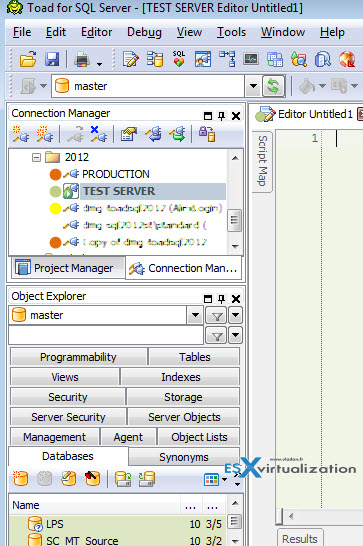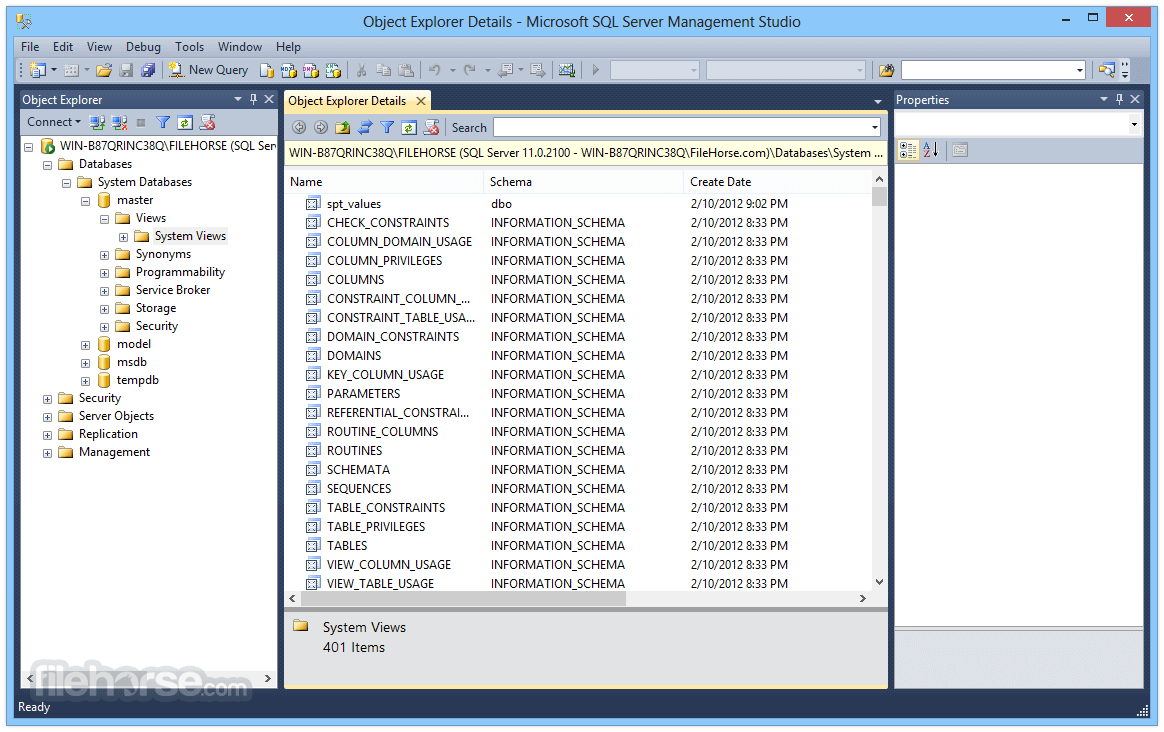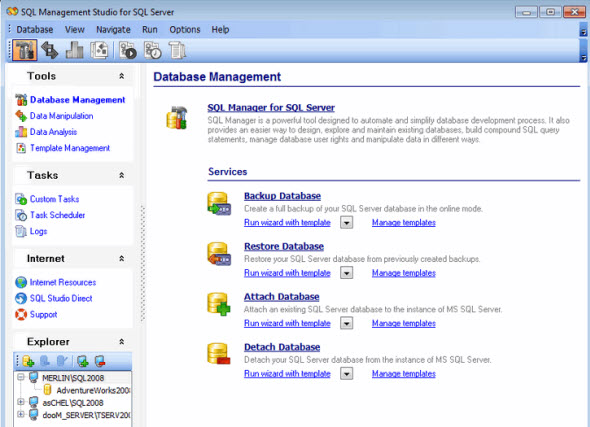Prerequisites
Navicat for SQL Server for Mac OS v.9.1 An ideal solution for administration and development which lets you create, edit databases, run SQL queries and connect to remote SQL Server in an easier way. It features an intuitive GUI and offers powerful visual tools such as Query Editor with. SQL Server 2019 Express is a free edition of SQL Server, ideal for development and production for desktop, web, and small server applications. Download now Install SQL Server 2019 on Windows, Linux, and Docker containers. SQLPro for MSSQL is the Premier application for editing and viewing SQL Server databases on mac os x. If you see a message like this, congratulations — SQL Server is now up and running on your Mac! If you prefer to use a GUI to manage SQL Server, read on. Azure Data Studio The Azure Data Studio dashboard. Azure Data Studio is a free GUI management tool that you can use to manage SQL Server on your Mac. You can use it to create and manage. There is not, but as of November SQL Operations Studio is in public preview and runs on Mac. It's not a replacement for SSMS but rather is aimed at developers for writing, testing, and executing code. It also provides limited administrative functionality and is customizable and extensible. It has a long way to go but is a good first start.
Microsoft SQL Server 2017 (Express Edition) – download link from the Microsoft site
Microsoft SQL Server Management Studio 18.2 - download link from the Microsoft site
DataGrip 2019.1 and later – download link from the JetBrains site
Step 1. Configure the SQL Server Configuration Manager
To open SQL Server Configuration Manager, open the Search dialog on Windows and type SQLServerManager14.msc (for Microsoft SQL Server 2017). Double-click the found result. If you use other versions of Microsoft SQL Server, change the second digit before .msc:
SQLServerManager13.mscfor SQL Server 2016SQLServerManager12.mscfor SQL Server 2014SQLServerManager11.mscfor SQL Server 2012
Run the SQL Server Browser
SQL Server Browser listens for incoming requests and provides information about Microsoft SQL Server instances on the computer. Play snes games online mac. For more information about SQL Server Browser, see SQL Server Browser in the Microsoft documentation.
If the SQL Server Browser menu items are disabled, try to enable the SQL Server Agent service.
In the SQL Server Configuration Manager, click SQL Server Services.
In the right pane that lists server services, right-click SQL Server Browser and select Start.
Enable SQL Server Agent
If the SQL Server Browser is running, you can skip this procedure.
SQL Server Agent is a Microsoft Windows service that executes scheduled administrative tasks. For more information about the service, see SQL Server Agent in the official Microsoft documentation. Ensure that SQL Server Agent is running and starts automatically. After the change, a restart might be required.
Navigate to Control Panel | Administrative Tools | Services.
In the Services window, right-click SQL Server Agent(<server_name>) and select Properties. For this tutorial, <server_name> is MSSQLSERVER.
From the Startup type list, select Automatic and click Start.
Enable the TCP/IP connection
In the SQL Server Configuration Manager, expand SQL Server Configuration and click Protocols for MSSQLSERVER, where MSSQLSERVER is a name of the Microsoft SQL Server instance.
In the list of protocol names, right-click TCP/IP and select Properties.
On the Protocol tab, from the Enabled list, select Yes.
On the IP Addresses tab, find the interface that your workstation uses and see the connection port. By default, the port is 1433. Verify that other running applications do not use the same port.
If you changed any settings, restart the server. For most situations, the restart resolves connection problems.
Step 2. Configure SQL Server Management Studio (SSMS)
Create a user
In the SQL Server Management Studio (SSMS), navigate to Security | Logins.
Right-click the Logins root folder and select New Login.
On the General page, specify a login name in the Login name field.
Select authentication mode. You can select between the following authentication modes:
Windows authentication: to use your domain login and password.
SQL Server authentication: to use a custom login and password. If you select Enforce password security policy checkbox, the user must change the assigned password before connecting to Microsoft SQL Server with DataGrip. Otherwise, clear the Enforce password security policy checkbox.
Click OK.
Configure user roles
Right-click the created user profile and select Properties.
On the Server Roles page, select the appropriate user role (for example, sysadmin).
Step 3. Connect to Microsoft SQL Server with DataGrip
The following section describes configuration of DataGrip on Windows, macOS, and Linux. Note that the Use Windows domain authentication checkbox is available only on Windows. To configure Windows domain authentication on macOS and Linux, see Connect by using Windows domain authentication.
Windows
Connect by using SQL Server authentication
Navigate to File | Data Sources or press Ctrl+Alt+Shift+S.
In the Data Sources and Drivers dialog, click the Add icon () and select Microsoft SQL Server.
Click the Driver link and select Microsoft SQL Server (jTds).
At the bottom of the data source settings area, click the Download missing driver files link. Alternatively, you can specify user drivers for the data source. For more information about user drivers, see Add a user driver to an existing connection.
In Host, Instance, and Port fields, specify your connection details.
From the Authentication list, select User and Password.
In User and Password fields, specify your credentials.
To ensure that the connection to the data source is successful, click Test Connection.

Connect by using single sign-on for Microsoft SQL Server
If you run DataGrip on Windows in the same domain as the Microsoft SQL Server database, you can use the Single-Sign On (SSO).
Navigate to File | Data Sources or press Ctrl+Alt+Shift+S.
In the Data Sources and Drivers dialog, click the Add icon () and select Microsoft SQL Server.
Click the Driver link and select Microsoft SQL Server (jTds).
At the bottom of the data source settings area, click the Download missing driver files link. Alternatively, you can specify user drivers for the data source. For more information about user drivers, see Add a user driver to an existing connection.
From the Authentication list, select Windows credentials.
To ensure that the connection to the data source is successful, click Test Connection.
Connect by using Windows domain authentication
Navigate to File | Data Sources or press Ctrl+Alt+Shift+S.
In the Data Sources and Drivers dialog, click the Add icon () and select Microsoft SQL Server.
Click the Driver link and select Microsoft SQL Server (jTds).
At the bottom of the data source settings area, click the Download missing driver files link. Alternatively, you can specify user drivers for the data source. For more information about user drivers, see Add a user driver to an existing connection.
In Host, Instance, and Port fields, specify your connection details.
From the Authentication list, select Domain credentials.
In the Domain field, specify the domain (for example,
DEVELOPMENT).In User and Password fields, specify your domain credentials. In the User field, type your domain user without the domain prefix (for example,
John.Smithinstead ofDOMAINJohn.Smith).Alternatively, on the General tab, specify the connection string. Consider the following example of a full connection string:
jdbc:jtds:sqlserver://UNIT-670:1433;domain=DEVELOPMENT;instance=MSSQLSERVER;databaseName=guest;To ensure that the connection to the data source is successful, click Test Connection.
macOS and Linux
Connect by using SQL Server authentication
Navigate to File | Data Sources or press ⌘;.
In the Data Sources and Drivers dialog, click the Add icon ( ) and select Microsoft SQL Server.
Click the Driver link and select Microsoft SQL Server (jTds).
At the bottom of the data source settings area, click the Download missing driver files link. Alternatively, you can specify user drivers for the data source. For more information about user drivers, see Add a user driver to an existing connection.
In Host, Instance, and Port fields, specify your connection details.
From the Authentication list, select User and Password.
In User and Password fields, specify your credentials.
To ensure that the connection to the data source is successful, click Test Connection.
Connect by using Windows domain authentication
Navigate to File | Data Sources or press ⌘;.
In the Data Sources and Drivers dialog, click the Add icon ( ) and select Microsoft SQL Server.
Click the Driver link and select Microsoft SQL Server (jTds).
At the bottom of the data source settings area, click the Download missing driver files link. Alternatively, you can specify user drivers for the data source. For more information about user drivers, see Add a user driver to an existing connection.
In Host, Instance, and Port fields, specify your connection details.
From the Authentication list, select Domain credentials.
In the Domain field, specify the domain (for example,
DEVELOPMENT).In User and Password fields, specify your domain credentials. In the User field, type your domain user without the domain prefix (for example,
John.Smithinstead ofDOMAINJohn.Smith).Alternatively, on the General tab, specify the connection string. Consider the following example of a full connection string:
jdbc:jtds:sqlserver://UNIT-670:1433;domain=DEVELOPMENT;instance=MSSQLSERVER;databaseName=guest;To ensure that the connection to the data source is successful, click Test Connection.
This guide shows you how to use Docker to pull a MSSQL Server image and run it. Azure Data Studio is a cross-platform database tool that will be using to connect our Docker container with MSSQL and execute SQL statements.
At the end, I will show you how to import a database to the Docker file system so that you can access it through Azure Data Studio.
Microsoft Sql Server Management Studio For Mac 64-bit
Check out other related guides here:
We will be touching on the technologies shown below:
- Database: Microsoft SQL Server
- Container to pull mssql-server-demo: Docker
- Installer for mssql-cli: Node.js (Run-time Environment) / Node Package Manager (NPM)
- Database tool and GUI: Azure Data Studio
Building our Environment with Docker
Installing Docker
Full guide for this portion here:
- Download Docker CE (Community Edition) for Mac here.
- To install, double-click on the .dmg file and then drag the Docker application icon to your Application folder.
What is Docker?
Docker is a platform that enables software to run in its own isolated environment. SQL Server (from 2017) can be run on Docker in its own isolated container.
Once Docker is installed, you simply download — or “pull” — the SQL Server on Linux Docker Image to your Mac, then run it as a Docker container. This container is an isolated environment that contains everything SQL Server needs to run.
Launch Docker
Open your Docker application, it should be located in the Applications folder.
Increase the Memory
By default, Docker will have 2GB of memory allocated to it. SQL Server needs at least 3.25GB. To be safe, increase it to 4GB if you can. Since this is just a playground, 2GB should be enough.
Optional - in case you want to increase memory size:
- Select Preferences from the little Docker icon in the top menu
- Slide the memory slider up to at least 2GB
- Click Apply & Restart
Download SQL Server
Open a Terminal window and run the following command.
This downloads the latest SQL Server 2019 for Linux Docker image to your computer.
You can also check for the latest container version on the Docker website if you wish.
Launch Docker Image
Run the following command to launch an instance of the Docker image you just downloaded:
Sql Management Studio For Mac
Example output:
Check the Docker container (optional)
You can type the following command to check that the Docker container is running.
If it’s up and running, it should return something like this:
If you accidentally closed your Docker App, open your terminal and type
Install the Node.js and NPM
Check if you have Node.js and NPM. Run the following commands in your terminal.
If you get an output with a version number, skip the rest of this section.
Then visit the Node.js website by clicking the following link:
Click the LTS version (the version number may be various) download button to download the Node.js package:
Next click and run the package after downloading. MacOS and Windows will have different installation process. Please follow the instruction to install the Node.js.
Then test again if Node.js and NPM were installed successfully by running the following commands in the terminal:

An output should look like this:
Install sql-cli
Run the following command to install the sql-cli command line tool. This tool allows you to run queries and other commands against your SQL Server instance.
If you get a permission error, use the sudo command:
Connect to MSSQL Server
Connect to your SQL Server using the mssql command, followed by the username and password parameters. Syntax: -u <username> -p <password>
Your output should look like this if you successfully connected:
Run a Quick Test
Run a quick test to check if you can connect to your SQL Server. Use the following SQL statement to check your SQL Server version:
If it’s running, you should see something like this:
Download an SQL Server GUI - Azure Data Studio
Azure Data Studio (formerly SQL Operations Studio) is a free GUI management tool that you can use to manage SQL Server on your computer. You can use it to create and manage databases, write queries, backup and restore databases, and more.
Azure Data Studio is available on Windows, Mac and Linux.
Install Azure Data Studio
To install Azure Data Studio onto your Mac:
- Visit the Azure Data Studio download page, and click the .zip file for macOS
- Once the .zip file has finished downloading, double click it to expand its contents
- Drag the .app file to the Applications folder (the file will probably be called Azure Data Studio.app)

Connect to SQL Server
Now that Azure Data Studio is installed, you can use it to connect to SQL Server.
- Launch Azure Data Studio. It is located in your Applications folder.
- Enter the login credentials and other information for the SQL Server instance that you’d like to connect to:
Microsoft Sql Server Management Studio For Mac Shortcut
It should look similar to this:
It should look similar to this:
Microsoft Sql Server Management Studio For Mac Catalina
- Server Name: localhost, [port number]
Example: localhost, 1433 - Authentication Type: SQL Login
- User name: [your SQL Server username] or sa
- Password: [your SQL Server password] or reallyStrongPwd123
- Database Name: <default>
- Server Group: <default>
If you use a port other than the default 1433, click Advanced and enter it in the Port field.
Alternatively, you can append it to your server name with a comma in between. For example, if you used port 1400, type in localhost,1400.
You can now go ahead and create databases, run scripts, and perform other SQL Server management tasks.

- Click New Query
Install Microsoft Sql Server Management Studio Mac
2. Type SELECT @@VERSION, then Click Run Query.
You should be able to see: Microsoft SQL Server in the Results.
Importing a sample database to your SQL Server using Azure Data Studio
Download the sample database file AdventureWorks
To get the OLTP downloads of AdventureWorks, go to this link and choose any sample database. In my example, I choose AdventureWorks2017.bak. We will upload this to the S3 Bucket.
Copying the file to your docker
Type the following command in the terminal following this syntax:
It should look like this:
If you forgot your container id, use the docker ps command.
Importing the sample database in Docker
Go to Azure Data Studio, and click the localhost, 1443, then choose Restore.
Then choose Backup file as the selection for Restore from. Next, click the blue button on the right of Backup file path.
Look for the sample database file. It should be located in
Choose Restore.
Check your localhost, 1443. It should generated a Database named AdventureWorks2017 and have contents such as Tables and Views. If not, right-click on localhost, 1443 and choose Refresh. You can also restart your Azure Data Studio application.
Testing the sample database
- Choose AdventureWorks2017 from the dropdown menu.
- Write a SQL query:

3. Click Run to run the query.
You should have an output like this:
Congratulations! ???
Resources:
Connect with me on LinkedIn here